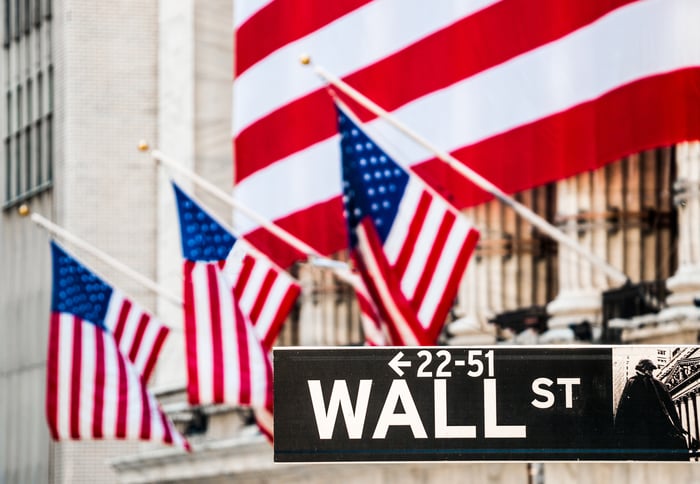Buckle up and hold on, because 2020 has been one heck of a ride for investors.
The coronavirus disease 2019 (COVID-19) pandemic initially caused a rout in equities during the first quarter. In less than five weeks, the broad-based S&P 500 shed 34% of its value, with the iconic Dow Jones Industrial Average (^DJI 0.69%) taking just 16 trading sessions to dip into bear market territory.
However, investor fortunes seemingly turned on a dime during the second quarter. This record-breaking volatility was followed by a ferocious rally for the S&P 500 and Dow that saw both indexes regain most of what they'd lost. The technology-dependent Nasdaq Composite even hit more than two dozen all-time highs.
Yet even after four strong months for equities, bargains remain. In particular, there are a trio of screaming buys currently among the Dow's 30 components.

Image source: Getty Images.
Walgreens Boots Alliance
Usually, healthcare stocks are relatively defensive investments. Since we don't get to choose when we get sick or what ailment(s) we develop, most healthcare companies tend to generate pretty consistent cash flow in any economic environment. This has, unfortunately, not been the case for pharmacy chain Walgreens Boots Alliance (WBA -0.93%) during the COVID-19 outbreak.
In recent months, Walgreens has seen a decline in foot traffic into its stores, which is partially a response to stay-at-home orders issued in various U.S. states. This has been a drag on lower-margin front-end sales and has also hurt revenue generation at its healthcare clinics. In total, Walgreens anticipates that COVID-19 will reduce its 2020 earnings per share by $1.03 to $1.14 for the full year.
While this isn't great news, there are still plenty of reasons to be excited about Walgreens Boots Alliance's long-term prospects. For one, the company is well-positioned to take advantage of an aging population with growing access to medical care. This is especially true in the U.S., where baby boomers are likely to rely on maintenance therapies for many decades to come. This suggests that Walgreens' higher-margin pharmacy segment should remain busy.
Walgreens is also making strides in personalized healthcare. Despite COVID-19 temporarily hurting foot traffic into its stores, the company has over 370 Healthcare Clinics in the U.S. that'll be welcoming folks for simple diagnoses and vaccines when the pandemic is over. Its Find Care digital platform is also tailored to help persons with chronic illnesses find physicians and specialists to help them live healthier lives. By driving more foot traffic into its stores and improving patient ease of care, Walgreens should have little trouble pointing the growth needle for its high-margin pharmacy segment in the right direction.
With a forward price-to-earnings ratio below 8, the time is right for value investors to pounce.

Image source: Getty Images.
JPMorgan Chase
Another screaming buy on the value radar is money-center bank JPMorgan Chase (JPM 1.44%).
There's little question that bank stocks are set for a challenging two-year period. With the Federal Reserve pushing its federal funds rate to a record-tying low of 0% to 0.25%, interest income for banks is going to fall. At the same time, the COVID-19-induced recession is likely to send mortgage, auto, and personal loan delinquencies higher. And, as the icing on the cake, banks have halted share buyback activity to conserve capital.
However, JPMorgan Chase is one of the best-capitalized banks in the country, and CEO Jamie Dimon has historically played things conservatively when navigating through recessions. In the most recent quarter, JPMorgan Chase set aside $10.5 billion to build up its reserves against possible credit losses, yet saw growth in virtually every operating segment, save for consumer banking loans. In fact, volatility led Markets segment revenue higher by 79% to $9.7 billion in Q2. Despite all of these challenges, the company still earned $4.7 billion in the quarter.
Like its big banking peers, JPMorgan Chase has also done an admirable job of controlling its expenses. Even while modestly expanding its physical footprint in select locations throughout the U.S., the company has witnessed a pretty steady uptick in digital banking and mobile app usage in consumer banking transactions. Since online and mobile transactions cost a mere fraction of what in-person interactions run, JPMorgan Chase continues to grow more operationally efficient.
At 28% above book value, JPMorgan Chase is at its most attractive valuation, relative to book, since 2015. That makes it an intriguing bet for long-term investors.

Image source: Getty Images.
Visa
Last, but not least, payment-processing giant Visa (V 0.65%) looks to be a screaming buy.
I know what you might be thinking: "Hey, isn't Visa valued at 33 times Wall Street's profit forecast for next year and susceptible to a slowdown in spending tied to COVID-19?" The answer here is yes, and yes. But it's also a company that's proved especially resistant during economic contractions, and it should be a prime beneficiary following the coronavirus pandemic.
The single greatest growth driver for Visa, at least in the near-term, is the shift away from cash as a source of payment. We've witnessed everything from cash shortages to the simple unwillingness of consumers to use cash, with bills viewed as a harbinger of germs. That's opening the door for plastic and other peer-to-peer payments platforms.
Within the U.S., Visa is king. It controls approximately 53% of all credit card network purchase volume, which is an enviable position to hold in the country with the highest global gross domestic product (GDP). And did I mention that 70% of U.S. GDP is derived from consumption?
But Visa has opportunities beyond the borders of the U.S., as well. It acquired Visa Europe in 2016, and plans to infiltrate underserved regions of the world where cash is still king, such as the Middle East and Africa.
Best of all, because Visa is a payment processor and not a lender, it isn't clobbered by credit delinquencies like most financial stocks. This is a big reason why its profit margins are typically above 50%.
When Visa dips in by any meaningful amount, history says you should buy.





